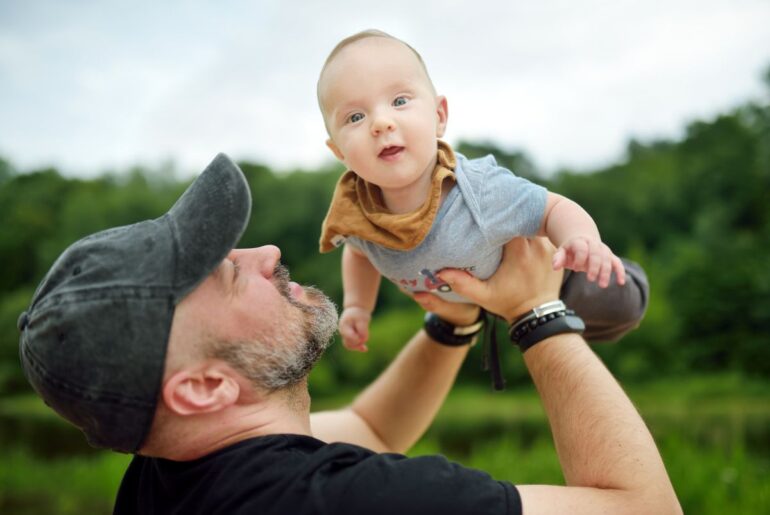When you’re a new parent, your baby might seem like a helpless creature that cries, eats, and sleeps on repeat. They’re not exactly a kid yet, doing classic “kid” things like playing pretend superheroes or tossing a ball. But even if their attention span, social abilities, and motor skills haven’t quite ramped up yet, don’t let that stop you from making an effort to play with your baby.
“Play” can be interpreted loosely for very young babies under about 6 or 9 months, and you may need to adjust your previous expectations — but it still has enormous benefits that will help your baby develop as well as bond with you! And don’t worry, you don’t need a lot of time, complicated games or equipment to make the most of play time with your little one. Simplicity and repetition are key at this stage.
Here are some easy ideas for approaching play with your baby:
Silly face-to-face time
Babies learn a lot from observing faces, especially their caregivers’ faces. Having face-to-face time every day will not only help you form a special bond, but will help them pick up on social skills and language skills.
To make it compelling, get silly with your baby:
- Make funny noises, like animal noises or vehicle noises
- Make silly faces or show them different emotional reactions like surprise and suspicion
- Play peek-a-boo
- Tell them jokes, stories, and rhymes
It almost doesn’t matter what you say or do, or if it makes any sense at this stage. Just let loose and show your baby the range of what your human face can do! Your baby might not react the way you expect at first, but over time they may start to smile, laugh, or try to imitate you, and those can be exciting milestones to witness.
Let them sample textures
You don’t need any fancy toys to start your baby with tactile learning. Take out different fabrics and materials — anything from a rough cardboard box to a swishy jacket to your softest robe — and let them explore. If the room is quiet enough, they’ll be able to experience the subtle sound differences in the materials too.
If your baby can’t grasp objects yet, you can still touch the materials to their arms, hands, belly, or face, and/or demonstrate them on yourself. And while you’re at it, tell them out loud what each object is and what it feels/sounds like, and help boost their language development.
Get creative with tummy time
A lot of parents feel pressure around getting their babies to do “tummy time.” The real goal is to let your baby try to use their body on their own and to do something besides lay on their back or cuddle with you. Yes, you do want to place them on their belly for a little while each day, and it’s okay if your baby doesn’t seem to like it at first. You can try waiting a little longer each day before scooping them up.
To add interest, give them different patterned objects to look at and try to touch — like a high-contrast black-and-white book, a striped stuffed animal, or a checkered quilt. Or get down on the floor with them, and do your silly face-to-face time or show them different stretches or exercise moves.
Fingers, toes, knees, and noses
You can help your baby learn to be aware of their body, teach communication skills, and get in some quality bonding time, all by playing a few simple “games” with body parts. Here are a few suggestions to start with:
- Count their toes and fingers in funny voices
- Chant “This Little Piggy” while wiggling each of their toes
- Name their main body parts and yours, while a stuffed animal gives kisses or jumps on noses, knees, etc.
- Do your best rendition of “Head, Shoulders, Knees and Toes” (and don’t worry about the quality of your singing voice — you have the most forgiving audience!)
Fun with music
You don’t have to be musically talented in the least to introduce your baby to the joys of music. Babies and kids of all ages (and adults!) can get endless benefits from the pleasing patterns of music.
Here are some simple ideas that you can try regardless of your musical training or abilities:
- Put on a good song and sing along or lip sync to your heart’s content
- Dance together — move their arms/legs or sway to the music
- Drum on a table or a box — your baby will be fascinated by the noises, especially if you change the patterns to make them faster and slower, quieter and louder
- Make up silly songs about everyday routines, like changing diapers or putting on clothes — this can also help keep them from wiggling away, and make the routine more enjoyable for both of you
Playing with your baby, even just for a few minutes at a time, will add joy to your days and boost your child’s development. The “play” may not seem reciprocal yet, but rest assured that you’re doing an amazing job helping your little one learn about the world around them.







